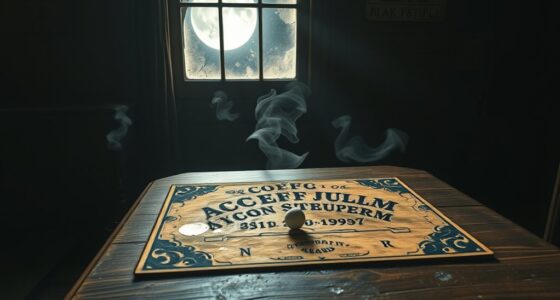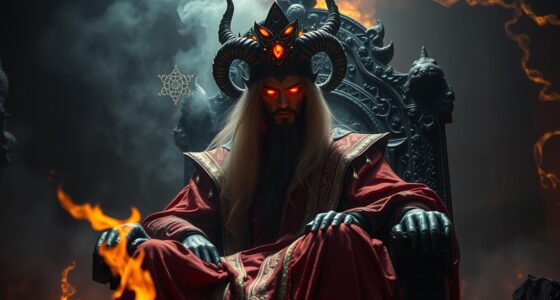The legend of Bloody Mary blends fact and fiction, rooted in the reign of Mary I of England, who earned her nickname from her brutal persecution of Protestants. This tale also intertwines with other historical figures like Elizabeth Bathory and mythic elements that reflect societal fears about female power and violence. The ritual itself offers a psychological exploration of fear and suggestion. If you’re curious, there’s more to uncover about the cultural significance and the complexities behind this haunting legend.
Key Takeaways
- The historical figure of Bloody Mary refers to Mary I of England, known for her persecution of Protestants during her reign from 1553 to 1558.
- The urban legend of Bloody Mary involves a mirror ritual, reflecting societal fears about female power and the supernatural.
- Psychological explanations suggest the ritual can induce hallucinations and heightened emotional states, making participants perceive supernatural events.
- The legend has evolved, intertwining with various cultural narratives and showcasing universal themes of horror and the unknown.
- Engaging with the Bloody Mary tale fosters communal bonds among youth and reflects collective anxieties surrounding violence and femininity.
Historical Context of Bloody Mary
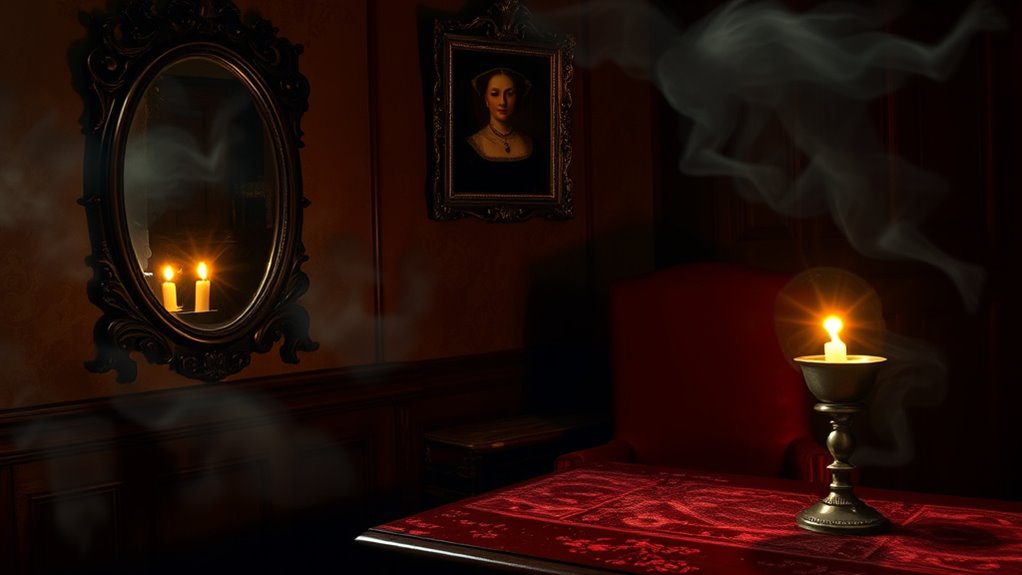
Although the nickname “Bloody Mary” conjures images of a vengeful spirit, it actually refers to Mary I of England, a queen whose reign from 1553 to 1558 was marked by intense religious conflict.
Her efforts to restore Roman Catholicism led to the execution of around 280 Protestants, many of whom were burned at the stake as heretics. This violent approach to governance earned her the nickname Bloody Mary and framed her as a tyrant in history.
Mary I’s brutal quest to restore Catholicism resulted in the execution of 280 Protestants, cementing her legacy as Bloody Mary.
However, it’s essential to understand that Mary I’s actions were influenced by her father’s split with the Catholic Church and the rising tide of Protestantism.
Historians now advocate for a more nuanced view of her reign, reflecting the complexities of 16th-century England.
The Legend of Bloody Mary
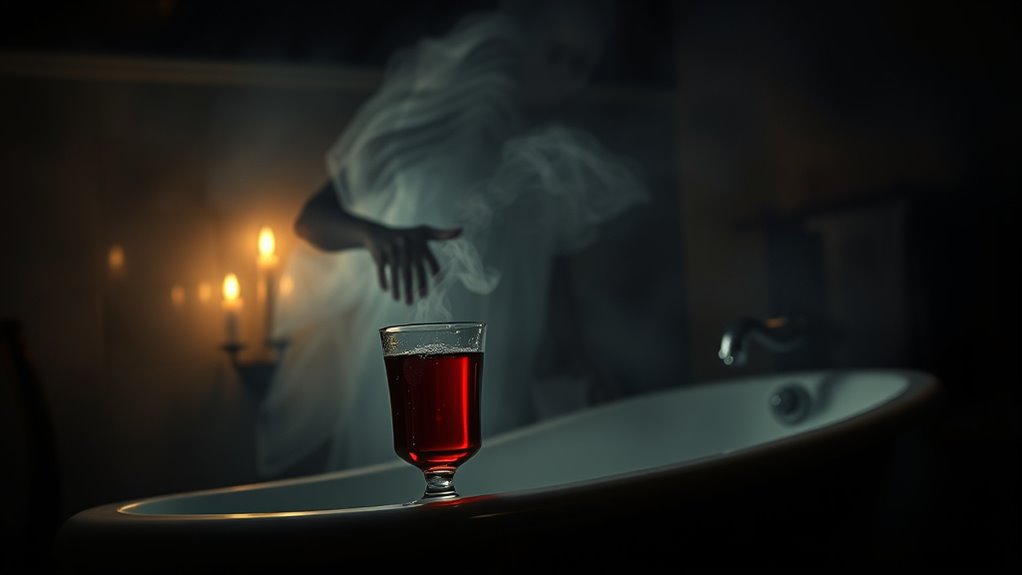
When you think about the legend of Bloody Mary, historical origins are key to understanding its chilling appeal.
This tale, woven with threads of cultural significance, reflects deep societal fears about female power and violence.
Today, the legend continues to evolve, enchanting imaginations across various cultures.
Historical Origins Explored
The legend of Bloody Mary has deep historical roots, drawing inspiration from several notorious figures throughout history. Most significantly, Queen Mary I of England earned the title “Bloody Mary” due to her ruthless persecution of Protestants, which instilled fear in many.
Another potential source is Elizabeth Bathory, the infamous “Blood Countess,” whose gruesome reputation for murdering young women adds to the legend’s dark allure. Additionally, Mary Worth, often viewed as a witch, contributes to the narrative despite her fictional status.
The urban legend claims that chanting “Bloody Mary” 13 times before a mirror can summon her spirit, tapping into societal fears and superstitions about the supernatural. This blend of history and folklore creates a chilling tale that captivates imaginations.
Cultural Significance Today
As you explore the cultural significance of Bloody Mary today, you’ll find that this haunting legend resonates deeply with contemporary society.
Rooted in the history of the English Queen Mary I, known for her violent persecution of Protestants, Bloody Mary’s tale embodies fear and power. The ritual of chanting her name in a mirror serves as a rite of passage for young people, reflecting modern anxieties about the supernatural.
Variations of the legend across cultures show its universal themes of horror and the unknown. In addition, the psychological effects experienced during the ritual illustrate the intersection of folklore and the mind.
Ultimately, Bloody Mary’s cultural significance prompts discussions about gender roles, historical narratives, and the implications of female power and violence.
Queen Mary I: The Historical Figure
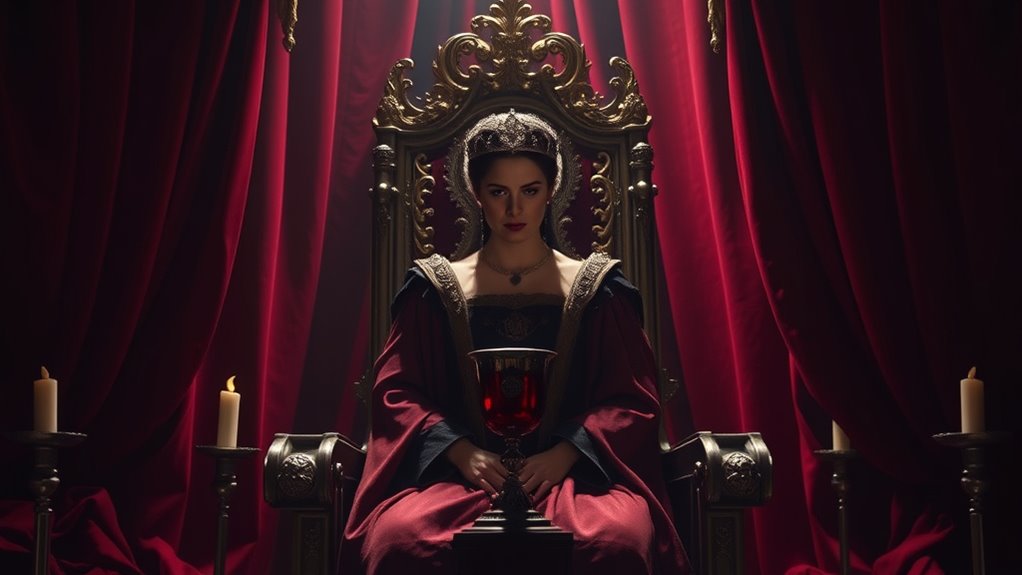
Queen Mary I, often overshadowed by her more famous half-brother Edward VI and her successor Elizabeth I, stands as a pivotal figure in English history.
As the daughter of Henry VIII and Catherine of Aragon, Mary became the first English queen to rule independently when she ascended the throne in 1553.
Her reign was marked by a fervent attempt to restore Roman Catholicism, resulting in the execution of about 280 Protestants, which earned her the notorious nickname “Bloody Mary.”
Mary I’s reign was defined by her zealous pursuit of Catholic restoration, leading to the execution of approximately 280 Protestants.
Facing challenges from the Protestant Reformation and health issues, her personal struggles influenced her decisions.
Today, historians are reevaluating Mary I’s legacy, aiming to understand her actions within the complex religious and political conflicts of her time rather than simply labeling her a tyrant.
Elizabeth Bathory and Her Infamous Crimes
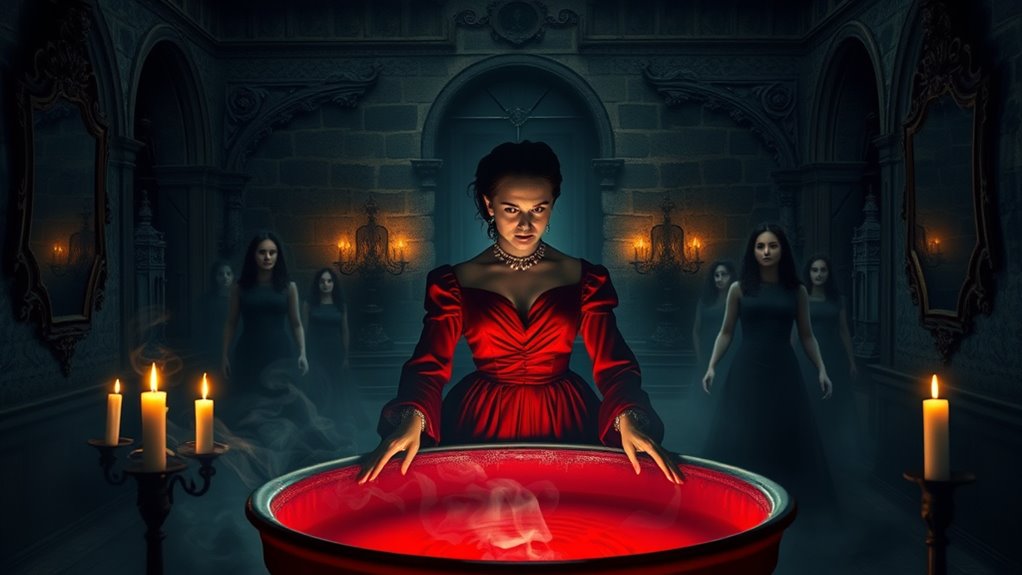
When you think of Elizabeth Bathory, the ‘Blood Countess,’ her life and marriage to Count Ferenc Nadasdy might come to mind, setting the stage for her notorious crimes.
You’ll discover her methodical torture techniques, which reflect a chilling cruelty that still horrifies today.
The historical controversies surrounding her actions raise questions about the truth behind her infamous legacy.
Life and Marriage
Although Elizabeth Bathory is often remembered for her gruesome legacy, her early life and marriage played a significant role in shaping her dark path. At just 15, she married Count Ferenc Nadasdy, a man known for his brutal military tactics. This relationship may have influenced her later sadistic behavior.
Here are four key aspects of her life and marriage:
- Early marriage at 15, aligning her with a violent partner.
- Nadasdy’s military influence possibly normalizing cruelty.
- Escalation of horrific acts after his death in 1604.
- Targeted young women, echoing myths like that of Mary Worth.
Her chilling tale continues to resonate, especially in the context of women with violent tendencies, often reflected in the bathroom mirror of history.
Methodical Torture Techniques
Elizabeth Bathory’s reign of terror is marked by a staggering number of victims, with estimates suggesting she murdered up to 600 women.
Using her noble status to evade justice, she employed methodical torture techniques that horrified even her contemporaries. One of her cruelest methods involved honey traps, where she’d cover her victims in honey and leave them to be stung by bees. Additionally, she subjected them to ice baths, causing excruciating pain.
After her husband’s death in 1604, she escalated her attacks, focusing on female servants and young noblewomen.
Though she was eventually sentenced to house arrest in 1610, the sensational nature of her crimes solidified her status as one of history’s most infamous female serial killers, fueling her enduring legend.
Historical Controversies Surrounding Crimes
While many tales of Elizabeth Bathory’s heinous acts have circulated over the centuries, the historical context surrounding her crimes remains fraught with controversy.
You might wonder about the following key aspects:
- Bathory allegedly murdered up to 600 young women, primarily targeting servants and noblewomen.
- Her crimes reportedly escalated after the death of her husband in 1604, leading to increasingly cruel torture methods.
- In 1610, she faced house arrest instead of trial, as her noble status protected her from execution.
- Testimonies against her are often questioned, as some were obtained under dubious circumstances, casting doubt on the veracity of the accusations.
These factors complicate the narrative of Bathory as a straightforward villain in history.
The Myth of Mary Worth
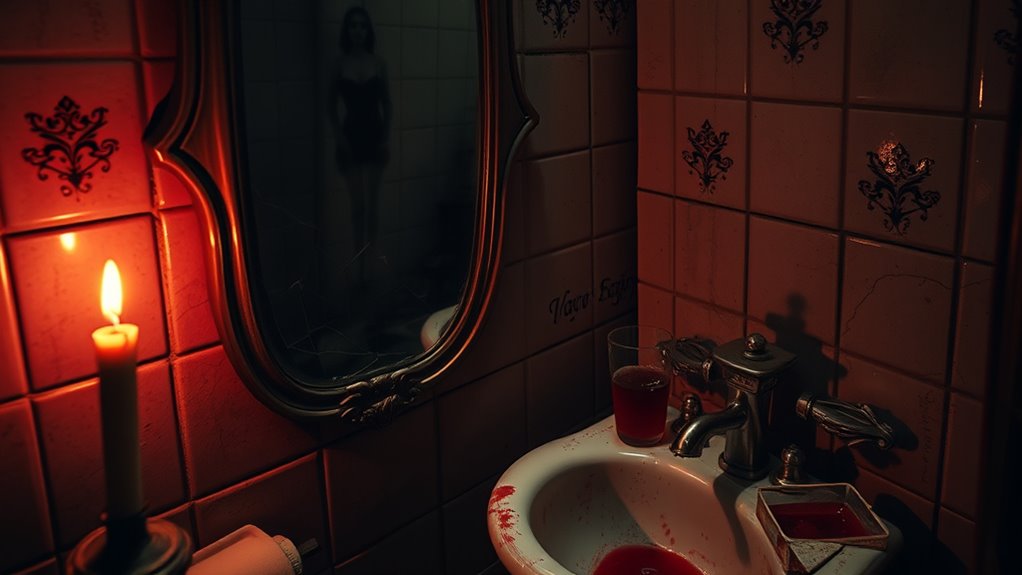
As you explore the legend of Mary Worth, you’ll find that her portrayal as a witch is steeped in folklore rather than historical fact. There’s little evidence to suggest she ever existed as a real individual; instead, she may be a fictional character or a blend of several women wrongfully accused of witchcraft.
The tales surrounding Mary reflect societal fears and the scapegoating of women, especially during times of turmoil. Unlike well-documented figures like Mary I of England, her story lacks substantial corroboration, emphasizing her mythic nature.
Curiously, Mary Worth’s narrative has morphed into an urban legend, highlighting themes of female empowerment and victimization, while showcasing our culture’s ongoing fascination with the supernatural and ghostly tales.
The Ritual of Summoning Bloody Mary
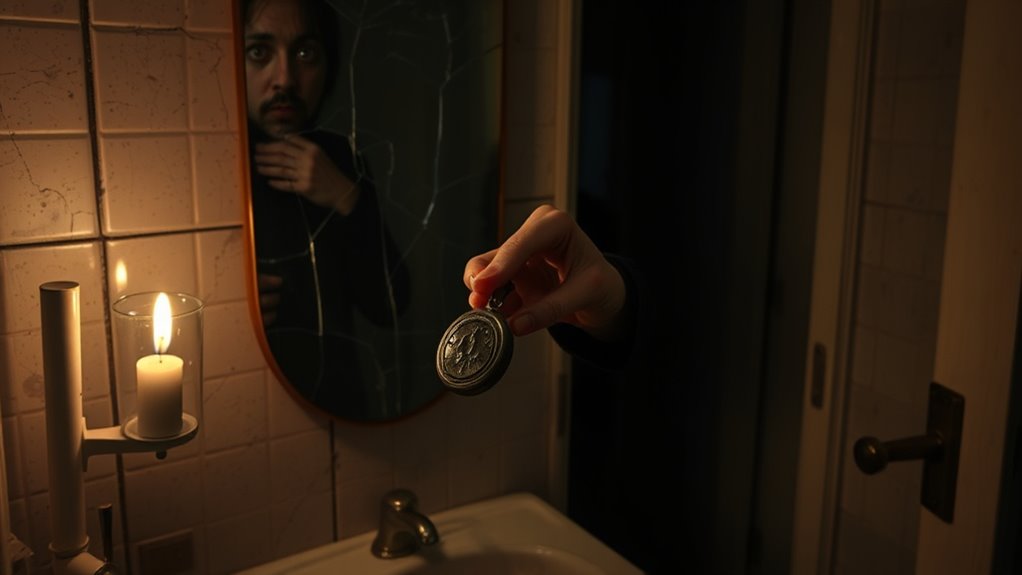
To summon Bloody Mary, you typically engage in a ritual steeped in superstition and folklore. Here’s how you can perform it:
- Prepare your setting: Find a dark room, preferably with a mirror, and light a candle.
- Walk backward: As you ascend a staircase, hold the candle and mirror, believing that this will reveal your future husband’s face.
- Chant her name: In front of the dimly lit mirror, repeatedly say “Bloody Mary” or variations like “Hell Mary” or “Mary Worth.”
- Wait for a vision: If you see a skull or Grim Reaper, it’s said to foreshadow your untimely death before marriage.
This ritual reflects cultural anxieties and societal values, particularly among the youth.
Psychological Explanations Behind the Legend
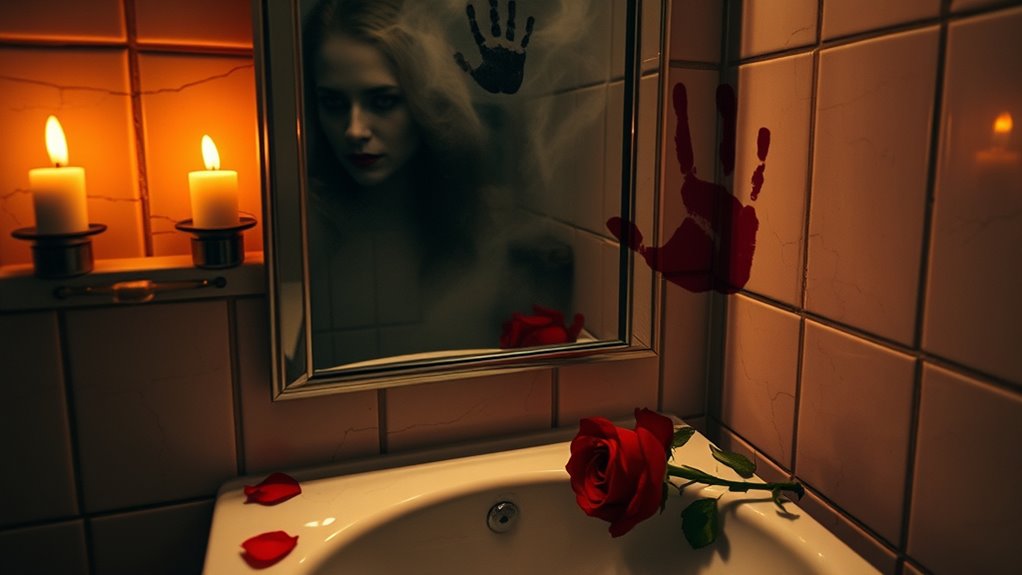
The eerie allure of the Bloody Mary ritual doesn’t just stem from folklore; psychological factors play a significant role in the experiences people have during it. Gazing into a mirror can induce dissociation or hallucinations, making you more likely to see supernatural figures. The Troxler effect might cause peripheral images to fade, enhancing the illusion of ghostly apparitions.
In group settings, suggestibility and shared fear amplify the experience, turning the ritual into a powerful collective event. Emotional states like fear trigger your brain’s fight-or-flight response, leading to vivid sensory experiences.
| Psychological Factors | Effects on Experience | Implications |
|---|---|---|
| Dissociation | Hallucinations | Perceived supernatural events |
| Troxler Effect | Faded peripheral images | Ghostly sightings |
| Group Dynamics | Amplified fear | Stronger belief in the legend |
Cultural Interpretations of Bloody Mary
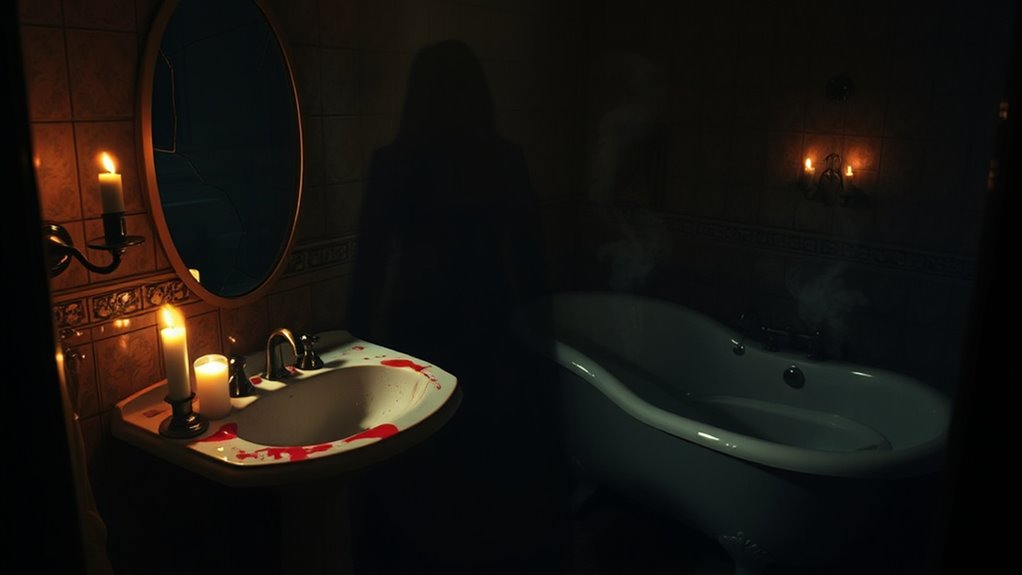
While many associate the Bloody Mary legend with a simple childhood game, its cultural interpretations reveal deeper societal fears and historical contexts. This urban legend, often tied to Queen Mary I of England, reflects various anxieties across cultures.
Here are some key interpretations:
- Historical Context: Tied to Queen Mary’s persecution of Protestants, portraying her as a vengeful spirit.
- Global Variations: Rituals like Japan’s Hanako-san showcase local fears.
- Adolescent Ritual: Chanting her name in mirrors highlights themes of superstition and youth anxiety.
- Societal Anxieties: Intertwined with fears of violence, femininity, and the supernatural, revealing cultural values.
These interpretations illustrate how folklore reflects and shapes societal concerns across different eras and communities.
The Impact of Folklore on Society

As folklore weaves its way through society, it shapes and reflects our collective fears, values, and identities. The Bloody Mary legend, in particular, highlights anxieties surrounding violence, femininity, and the supernatural.
By engaging with this tale, you explore societal norms and moral lessons about women’s roles. Urban legends like Bloody Mary not only entertain but also create communal bonds, especially among youth, as they share these stories in social settings, reinforcing group identity.
Furthermore, the psychological effects of the ritual can induce hallucinations or heightened emotions, showcasing folklore’s influence on behavior.
Over time, the storytelling around Bloody Mary has evolved, revealing a dynamic relationship between folklore and societal change, ultimately shaping perceptions of history and culture.
Reassessing the Legacy of Mary I and Her Namesakes
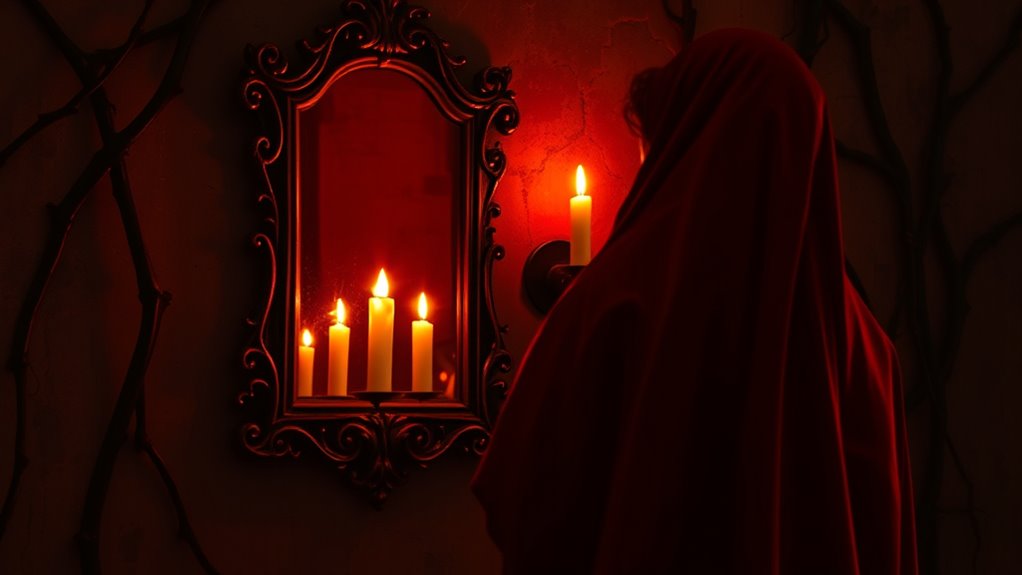
When you think about Mary I, it’s essential to reflect on the historical context of her reign and the intense religious conflicts of her time.
The myths surrounding her, like the urban legend of Bloody Mary, often blur the line between fact and fiction, influencing how we view her legacy today.
Historical Context Matters
Understanding the legacy of Mary I requires delving into the historical context that shaped her reign and the societal fears of her time. Her infamous actions during a period of intense religious conflict highlight the complexities of her governance.
Consider these key points:
- Mary I reigned from 1553 to 1558, executing around 280 Protestants in her quest to restore Catholicism.
- The Protestant Reformation challenged the authority of the Catholic Church, influencing her policies.
- Historians now reassess her legacy, focusing on the broader implications of her actions, including the emotional volatility that often accompanies leadership decisions made under societal pressure.
- The “Bloody Mary” urban legend reflects fears of female power and violence, complicating the understanding of her historical identity.
- The importance of celebrating relationships can also shed light on how societal perceptions of women in power have evolved over time.
Myth vs. Reality
While many people immediately associate the name “Bloody Mary” with the notorious ruler of England, the reality of her legacy is far more complex than the myths suggest. Mary I’s reign involved her efforts to restore Catholicism during a turbulent time, and her infamous nickname oversimplifies her struggles and motivations.
| Aspect | Myth | Reality |
|---|---|---|
| Execution Count | 280 Protestants | Reflects a broader religious conflict |
| Restoration Efforts | Solely a tyrannical ruler | Aimed to unify England under Catholicism |
| Historical Narratives | Simplified and sensationalized | Complex, influenced by gender politics |
| Folklore | Linked to urban legends | Overlaps with figures like Elizabeth Bathory |
Impact on Folklore
As the legacy of Mary I intertwines with modern folklore, her infamous moniker “Bloody Mary” serves as a lens through which we can explore societal fears and cultural narratives. This connection influences how we perceive power and violence, especially in women.
Consider these four aspects of her impact:
- Historical Actions: Mary I’s persecution of Protestants has led to her simplified image as a violent monarch.
- Urban Legend: The ritual of summoning Bloody Mary in front of a mirror likely springs from her notorious reputation.
- Associated Figures: Namesakes like Elizabeth Bathory deepen the narrative, reflecting fears of powerful women.
- Nuanced Legacy: Reassessing Mary I encourages understanding the complex interplay between history and evolving folklore.
Frequently Asked Questions
What Is Bloody Mary’s Origin Story?
Bloody Mary’s origin story blends history and myth.
You might hear about Queen Mary I of England, known for her harsh reign against Protestants, earning her the nickname “Bloody Mary.”
Another figure often mentioned is Elizabeth Bathory, who was accused of horrific acts.
Additionally, characters like Mary Worth embody societal fears of witchcraft.
The legend suggests that invoking her name in front of a mirror can summon her spirit, tapping into ancient divination practices.
Is Bloody Mary a Good or Bad Thing?
When you glance into a mirror, the reflection staring back feels familiar yet unsettling.
Is Bloody Mary a good or bad thing? It depends on your perspective. For some, she embodies fear and serves as a warning about consequences, while others see her as a symbol of strength, challenging societal norms.
Engaging with her story sparks discussions on morality and gender, inviting you to explore the duality of fear and empowerment within cultural folklore.
How to Summon Bloody Mary in Real Life?
To summon Bloody Mary, you’ll need a dimly lit room and a mirror.
Hold a candle for light, then chant “Bloody Mary” at least three times—some believe 13 times works better.
As you gaze into the mirror, focus intently; you might experience hallucinations or see a ghostly figure.
It’s best to try this with friends, but if you’re alone, be aware of the psychological effects it can have on you.
Why Was She Called Bloody Mary?
Mary I of England was like a storm cloud, darkening the skies of religious conflict with her reign.
She earned the nickname “Bloody Mary” due to her brutal persecution of Protestants, resulting in about 280 executions.
Her intense efforts to restore Catholicism after her father’s Protestant reforms led to a violent crackdown on dissent.
While her actions were extreme, they reflect the turbulent time she ruled and the struggles she faced personally.
Conclusion
In the end, the tale of Bloody Mary is like a shadow that dances between truth and fiction. While Queen Mary I’s reign was marked by turmoil, her legacy has been obscured by myths and folklore. From Elizabeth Bathory’s gruesome acts to the whispers of Mary Worth, these stories intertwine, creating a rich tapestry of fear and fascination. As you reflect on this legend, remember that history often wears a mask, revealing only what we dare to uncover.


